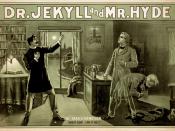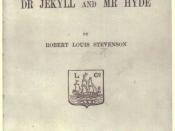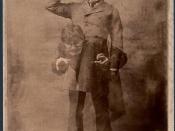The Gothic theory of the double is both reductive and powerful. It assumes that we are all playing a role in life; that a raving beast waits within for the chains to loosen or snap. Doubles stories seem to proliferate when people sense an unnegotiable divide between the true self and society, between nature and culture. (Edmunson 48) Such duality of roles is expressed in terms of split personalities in both The Beast in the Jungle by Henry James (1843-1916) and The Strange Case of Dr. Jekyll and Mr. Hyde by Robert Louis Stevenson (1850-1894). In these fictional works, the characters are unable to cope with the split.
Stevenson seeks to reproduce the double by way of splitting a personality between accepted roles. In this case, the roles are split between appropriate and inappropriate masculine behavior and are issustrated through the characterizations of Dr. Jekyll and Mr. Hyde. "Jekyll is an apparently respectable man", contends Calder (ii), "who contains within him a potential for profound wickedness, released in the shape of Mr.
Hyde". According to Calder (ii) "AJ Symonds, a friend of Robert Stevenson, and many others found this chilling to contemplate." The society of men is Stevenson's main focus and is evident in the number of ways in which he presents Hyde in terms of society. If Jekyll and Hyde is characterized in Gothic fiction's exaggerated tones of late-Victorian anxieties concerning deterioration of social status, and the idea of 'criminal man,', it invariably situates those concerns in relation to the practices and discourses of lawyers like Gabriel Utterson, doctors like Henry Jekyll and Hastie Lanyon, or even 'well-known men about town' like Richard Enfield. The novel in fact asks us to do more than simply register the all-too-apparent marks of Edward Hyde's 'degeneracy.' It also compels us also to...


